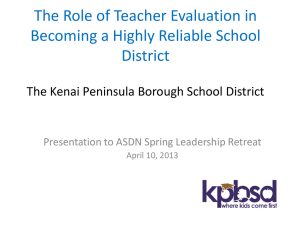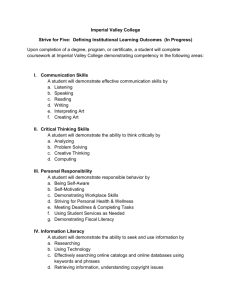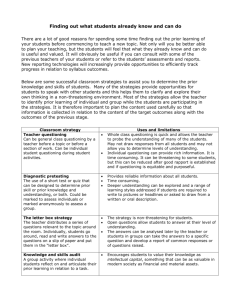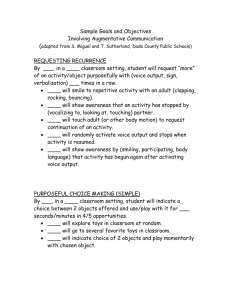Key Features of Effective Learning
advertisement
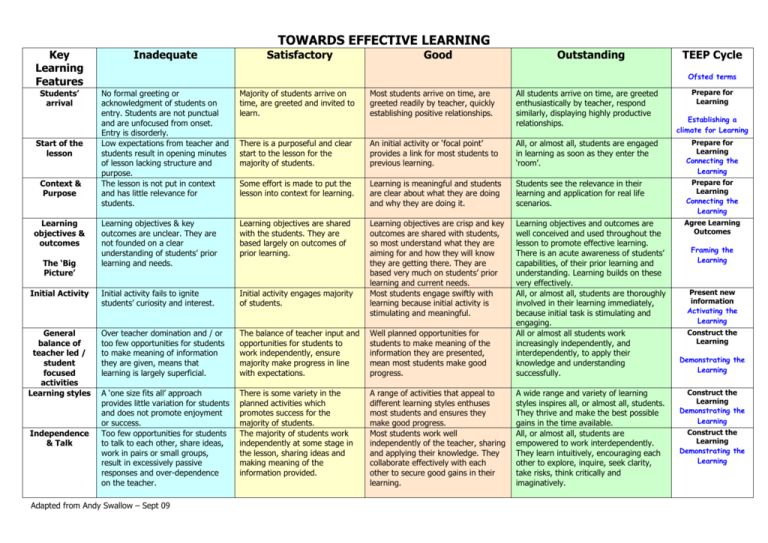
TOWARDS EFFECTIVE LEARNING Key Learning Features Inadequate Students’ arrival No formal greeting or acknowledgment of students on entry. Students are not punctual and are unfocused from onset. Entry is disorderly. Low expectations from teacher and students result in opening minutes of lesson lacking structure and purpose. The lesson is not put in context and has little relevance for students. Majority of students arrive on time, are greeted and invited to learn. Most students arrive on time, are greeted readily by teacher, quickly establishing positive relationships. All students arrive on time, are greeted enthusiastically by teacher, respond similarly, displaying highly productive relationships. There is a purposeful and clear start to the lesson for the majority of students. An initial activity or ‘focal point’ provides a link for most students to previous learning. All, or almost all, students are engaged in learning as soon as they enter the ‘room’. Prepare for Learning Connecting the Learning Some effort is made to put the lesson into context for learning. Learning is meaningful and students are clear about what they are doing and why they are doing it. Students see the relevance in their learning and application for real life scenarios. Prepare for Learning Connecting the Learning Learning objectives & key outcomes are unclear. They are not founded on a clear understanding of students’ prior learning and needs. Learning objectives are shared with the students. They are based largely on outcomes of prior learning. Initial activity fails to ignite students’ curiosity and interest. Initial activity engages majority of students. General balance of teacher led / student focused activities Learning styles Over teacher domination and / or too few opportunities for students to make meaning of information they are given, means that learning is largely superficial. The balance of teacher input and opportunities for students to work independently, ensure majority make progress in line with expectations. Well planned opportunities for students to make meaning of the information they are presented, mean most students make good progress. Learning objectives and outcomes are well conceived and used throughout the lesson to promote effective learning. There is an acute awareness of students’ capabilities, of their prior learning and understanding. Learning builds on these very effectively. All, or almost all, students are thoroughly involved in their learning immediately, because initial task is stimulating and engaging. All or almost all students work increasingly independently, and interdependently, to apply their knowledge and understanding successfully. Agree Learning Outcomes Initial Activity Learning objectives are crisp and key outcomes are shared with students, so most understand what they are aiming for and how they will know they are getting there. They are based very much on students’ prior learning and current needs. Most students engage swiftly with learning because initial activity is stimulating and meaningful. A ‘one size fits all’ approach provides little variation for students and does not promote enjoyment or success. Too few opportunities for students to talk to each other, share ideas, work in pairs or small groups, result in excessively passive responses and over-dependence on the teacher. There is some variety in the planned activities which promotes success for the majority of students. The majority of students work independently at some stage in the lesson, sharing ideas and making meaning of the information provided. A range of activities that appeal to different learning styles enthuses most students and ensures they make good progress. Most students work well independently of the teacher, sharing and applying their knowledge. They collaborate effectively with each other to secure good gains in their learning. A wide range and variety of learning styles inspires all, or almost all, students. They thrive and make the best possible gains in the time available. All, or almost all, students are empowered to work interdependently. They learn intuitively, encouraging each other to explore, inquire, seek clarity, take risks, think critically and imaginatively. Start of the lesson Context & Purpose Learning objectives & outcomes The ‘Big Picture’ Independence & Talk Satisfactory Good Outstanding TEEP Cycle Ofsted terms Adapted from Andy Swallow – Sept 09 Prepare for Learning Establishing a climate for Learning Framing the Learning Present new information Activating the Learning Construct the Learning Demonstrating the Learning Construct the Learning Demonstrating the Learning Construct the Learning Demonstrating the Learning TOWARDS EFFECTIVE LEARNING Questioning techniques Level of challenge & match of tasks ‘Taking hold …. letting go’ Feedback to students Attitude to work End of Lesson Learning, progress & achievement Questioning / discussion tends to be teacher dominated and rarely involves more than a third of students. Whole class questioning / discussion aids understanding, but involves a limited number of students. Activities contain low levels of challenge and do not build systematically on each other. Teacher has an insufficient understanding of students’ needs. Independent activities are not introduced with sufficient care. Examples of ‘what a good one looks like,’ whole class modelling, individual prompts / props are not in evidence. Activities are sufficiently challenging and sequenced to ensure that majority of students, including those with additional needs, make expected progress. Some thought is given to modelling ‘desirable outcomes’ before students are invited to work independently. Consequently, majority focus well and engage appropriately with planned activities. Regular, accurate assessment informs planning, which generally meets the needs of all groups of students. They are informed about their progress and how to improve through marking & dialogue with adults. Teachers monitor students’ work in lessons, pick up general misconceptions & adjust plans accordingly to support learning. Students generally show positive attitudes to their work. They largely enjoy learning in a safe & secure environment. Assessment takes too little account of the students’ prior learning and is not used effectively to help them improve. Consequently, they have little understanding about how well they are doing and what they need to do next. Opportunities for students to reflect on their own and others’ work, are missed. Students’ attitudes are poor. They do not enjoy their work. Many are constantly negative or passive. The learning environment is inimical to development of effective skills & qualities There is no formal close to the learning. Methods do not sufficiently engage the different groups of students. Up to one third make little progress in learning. Achievement is superficial and / or insecure, given starting points. Adapted from Andy Swallow – Sept 09 Formal end to learning indicates broadly what has been achieved. Majority of students [up to ¾] have made the progress that was expected by the end of the lesson. Their outcomes are generally secure and will be helpful for further learning. Most students are involved in answering / asking questions, discussing their learning, through whole class and independent opportunities. Work is closely tailored to the needs of different groups of learners so that most learn well and make good progress. All, or almost all, students show deep understanding, responding effectively to teacher’s questioning, in whole class and small group / pairs situations. Effective sharing of ‘what a good one looks like,’ together with suitable prompts for individual students, [as necessary], ensures most transfer swiftly to independent tasks and achieve well. Excellent demonstration ensures all, or almost, all, students know exactly what is expected of them. Appropriate prompts are available, for individual students, if required, enabling best possible gains in time available. As a result of good assessment procedures, teachers & other adults plan well to meet needs of all students. They are provided with detailed feedback, orally and through marking. They know how well they have done and can discuss what they need to do to sustain good progress. Teachers listen to, observe & question students in lessons to reshape tasks and improve learning. Students show good and enjoy what they do. They are keen & enthusiastic. They know that their efforts are valued and respond well to the frequent and well-directed praise they receive. Most students are involved in reviewing learning & progress and next steps in learning are identified. Marking & dialogue between teachers, other adults and students are consistently of a very high quality. Students understand in detail how to improve their work and are consistently supported in doing so. Teachers systematically & effectively check students’ understanding throughout lessons, anticipating where they may need to intervene and doing so with striking impact. All students show excellent attitudes to their work and enjoy what they do. Their motivation is authentic. They are reflective, responsive, resourceful, resilient, and reciprocal in their learning. Most students [at least 80%] have made good progress by the end of the lesson. They achieve deep understanding in their work and will be able to use their learning as a platform for subsequent activities. All, or almost all [at least 95%], students have made exceptional progress by the end of the lesson. Their learning is profound and they already demonstrate they can apply and use confidently the knowledge they have gained. All students, including those with additional needs, make exceptional progress, through work being tailored highly effectively to their needs. All, or almost all students are engaged in effectively reviewing learning and scene is set for future learning. Construct the Learning Demonstrating the Learning Construct the learning/ Apply to Demonstrate Demonstrating the Learning Apply to Demonstrate Supporting the Learning Review the Learning Assessing the Learning Review the Learning Assessing the Learning Review the Learning Consolidating the Learning Review the Learning Evaluating the Learning TOWARDS EFFECTIVE LEARNING Adapted from Andy Swallow – Sept 09
